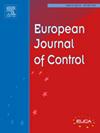Adaptive robust boundary control strategy for tension balance of steel wire rope in double rope winding hoisting system
IF 2.6
3区 计算机科学
Q2 AUTOMATION & CONTROL SYSTEMS
引用次数: 0
Abstract
Due to reasons such as manufacturing errors of the drum and inconsistent elastic deformation of ropes, the double rope winding hoisting system will have problems of unbalanced tension of the steel ropes and longitudinal vibration of the hoisting container. In response to this phenomenon, this paper proposes a parameter-adaptive robust boundary control strategy for rope tension balance. Firstly, by comprehensively considering the coupled vibration characteristics of the steel ropes, floating sheave, and containers, a distributed parameter dynamic model of the system is established. This model can accurately characterize the flexible features and nonlinear dynamics of the system. Secondly, aiming at tension difference suppression and vibration control, a robust boundary controller based on the precise model is designed using Lyapunov theory and Barbalat’s lemma. Furthermore, to address system modeling uncertainties and unknown disturbances, the Lyapunov function is redefined. Combined with the real-time online estimation of the unknown disturbance terms, the nonlinear feedback equation of the excitation force of the floating sheave is redesigned to form an adaptive robust boundary controller. Finally, experimental validation is conducted on a test platform. By simulating drum manufacturing deviations, the control effects of no control, traditional PID, and the proposed algorithm are compared. Results demonstrate that the proposed method significantly improves tension balance accuracy and operational stability.
双绳卷绕提升系统钢丝绳张力平衡的自适应鲁棒边界控制策略
由于卷筒制造误差、绳索弹性变形不一致等原因,双绳卷绕式提升系统会出现钢丝绳张力不平衡、吊装容器纵向振动等问题。针对这一现象,本文提出了一种参数自适应的绳张力平衡鲁棒边界控制策略。首先,综合考虑钢丝绳、浮轮和集装箱的耦合振动特性,建立了系统的分布参数动力学模型;该模型能准确表征系统的柔性特性和非线性动力学特性。其次,针对张力差抑制和振动控制,利用Lyapunov理论和Barbalat引理设计了基于精确模型的鲁棒边界控制器。此外,为了解决系统建模的不确定性和未知干扰,重新定义了李雅普诺夫函数。结合未知扰动项的实时在线估计,重新设计了浮轮激振力的非线性反馈方程,形成了自适应鲁棒边界控制器。最后,在测试平台上进行了实验验证。通过对卷筒制造偏差的仿真,比较了无控制、传统PID和本文算法的控制效果。结果表明,该方法显著提高了张力平衡精度和运行稳定性。
本文章由计算机程序翻译,如有差异,请以英文原文为准。
求助全文
约1分钟内获得全文
求助全文
来源期刊

European Journal of Control
工程技术-自动化与控制系统
CiteScore
5.80
自引率
5.90%
发文量
131
审稿时长
1 months
期刊介绍:
The European Control Association (EUCA) has among its objectives to promote the development of the discipline. Apart from the European Control Conferences, the European Journal of Control is the Association''s main channel for the dissemination of important contributions in the field.
The aim of the Journal is to publish high quality papers on the theory and practice of control and systems engineering.
The scope of the Journal will be wide and cover all aspects of the discipline including methodologies, techniques and applications.
Research in control and systems engineering is necessary to develop new concepts and tools which enhance our understanding and improve our ability to design and implement high performance control systems. Submitted papers should stress the practical motivations and relevance of their results.
The design and implementation of a successful control system requires the use of a range of techniques:
Modelling
Robustness Analysis
Identification
Optimization
Control Law Design
Numerical analysis
Fault Detection, and so on.
 求助内容:
求助内容: 应助结果提醒方式:
应助结果提醒方式:


